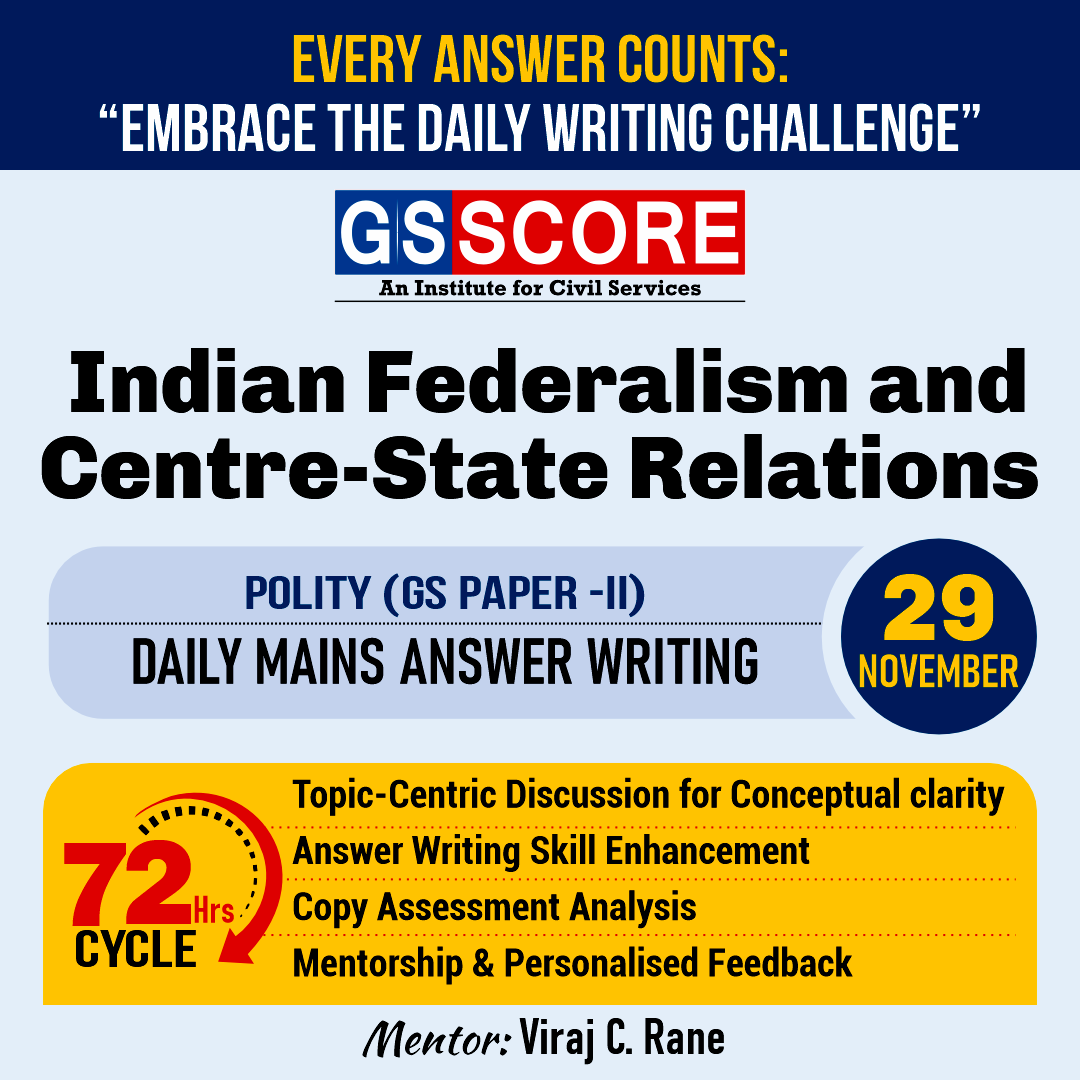


Instruction:
- There will be 2 questions carrying the First Question is-10 marks Write your answers in 150 words and the Second Question is-15 marks Write your answers in 250 words.
- Any page left blank in the answer-book must be crossed out clearly.
- Evaluated Copy will be re-uploaded on the same thread after 2 days of uploading the copy.
- Discussion of the question and one to one answer improvement session of evaluated copies will be conducted through Google Meet with concerned faculty. You will be informed via mail or SMS for the discussion.
Question #1. Why is the Inter-State River Water Disputes (ISWD) one of the most contiguous issues of federal water governance in India today? Highlight the recent measures taken in the Area of ISWD and suggest steps required for better federal water governance. 10 marks (150 words)
Question #2. Bring out the differences between Indian and U.S. federalism. Also, explain why India is called the indestructible union of destructible states. 15 marks (250 words)
(Examiner will pay special attention to the candidate's grasp of his/her material, its relevance to the subject chosen, and to his/ her ability to think constructively and to present his/her ideas concisely, logically and effectively).
STEPS & INSTRUCTIONS for uploading the answers
Step 1 - The Question for the day is provided below these instructions. It will be available at 7:00 AM.
Step 2 - Uploading of Answers : Write the answer in A4 Sheet leaving proper margins for comments and feedback and upload the PDF in MY ACCOUNT section. Click on the option of SUBMIT COPY to upload the PDF.
Step 3 - Deadline for Uploading Answers: The students shall upload their answers by 7:00 PM in the evening same day. The first 50 copies will be evaluated.
Step 4 - Feedback : Mentors will give their feedback for the answers uploaded. For more personalised feedback, join our telegram channel by clicking on the link https://t.me/mains_answer_writing_cse . A one-to-one session will be conducted with the faculty after copy evaluation in 72 Hrs.
Model Answer
Question #1. Why is the Inter-State River Water Disputes (ISWD) one of the most contiguous issues of federal water governance in India today? Highlight the recent measures taken in the Area of ISWD and suggest steps required for better federal water governance. 10 marks (150 words)
Approach
- The question demands analysis of Inter-State River Water Disputes
- Contextually introduce with Inter-State River Water Disputes and briefly highlight the Constitutional mechanism
- Discuss the reasons for the Interstate Water Disputes and Conflicting Federalism
- Then write about the measures taken in recent time to resolve this issue and suggest measures
- Conclude with the gist of your answer.
Hints:
Interstate (River) Water Disputes (ISWDs) are a continuing challenge to the nation. These disputes have a long history and the rulers of the regions or those who governed the areas pre and post independence contributed their mite to the contentious issues by pursuing their narrow interests. The disputes are constitutional, historico-geographical, and because of institutional ambiguities too. Nowadays, politics is adding to the controversies with politicians playing up ‘people’s demands’ to suit their vote banks prolonging the conflicts further.
Article 262 of Constitution
The Interstate River Water Disputes Act, 1956 (IRWD Act) is an Act of the Parliament of India enacted under Article 262 of Constitution of India on the eve of reorganization of states on linguistic basis to resolve the water disputes that would arise in the use, control and distribution of an interstate river or river valley.
Reasons for the Interstate Water Disputes and Conflicting Federalism:
- Ambiguous Legislative Powers: Inadequacy in the division of legislative powers concerning water resources is amorphous due to inadequate enforcement of the constitutional role originally envisioned for the Union government. The vacuum thus created has allowed states unregulated access to the waters of interstate rivers, often based on historical arrangements
- Conflicting Interests among the Sates: Interstate Rivers in India have become sites of contestation, fuelled by conflicting perceptions of property rights, flawed economic instruments for food security, the lack of an integrated ecosystems approach, and the prevalence of reductionist hydrology for water resource development.
- Contemporary Issues: Increasing water scarcity, a rapid rise in urban and rural demands for freshwater, and contentious political dynamics have further exacerbated the problem
- Historical & Geographical Ambiguity: The changing borders complicate the existing jurisdictional and resource-sharing agreements and eventually become sources of interstate political contestation, leading to historical-geographical ambiguity in interstate river water governance..
- The non-consensus approach in the Policies: The projects pertaining interlinking of rivers have received patronage from the governments, yet have not made much headway, partly due to the hurdles of interstate coordination. Similarly, the National Water Policy itself requires a consensus among states.
- In recent years, increasing water scarcity, a rapid rise in urban and rural demands for freshwater, and contentious political dynamics have further exacerbated the problem
Recent measures in the Area of ISWDs:
- Legislative Reforms: Two important Bills pertaining to water governance were passed by the Lok Sabha; these are,
- The Interstate River Water Disputes Amendment Bill 2019, which seeks to improve the inter-state water disputes resolution by setting up a permanent tribunal and
- The Dam Safety Act 2021, aims at building an inclusive and comprehensive framework for the management of India’s aging dams through inter-state and intra-state cooperation.
- Judicial Reforms: The Supreme Court has always been with an intent to interpret or give effect to tribunal awards. This appears to be true until the unprecedented Cauvery decision in 2018, in which the Court modified the Cauvery Water Disputes Tribunal award. This decision clearing way for an invariable escalation of the disputes to the Supreme Court,
- to solve the irrigation needs faced by the farmers of Tamil Nadu, and to fulfill the needs of both states.
Possible Solution for Inter-state water dispute in India:
- The Formation of National Water Policy: An inclusive National Water Policy is to be framed for the creation and nurturing of an ecosystem for Interstate River water cooperation as one of its priorities, and enunciate specific steps towards setting the process in motion.
- Establishment of the River Basin Authority: River Basin Authorities, or any other forms of interstate institutional models, under the River Basin Management Bill, 2018 can have positive responses in building upon the contours of the respective functional spaces emerging from the federal consensus.
- An enduring and empowered deliberative forum, such as the Inter-State Council, will enable such consensus-building and evolution of collaborative solutions.
- Inter-Ministerial Cooperation: The cooperation between the ministries, and departments, such as the Ministry of Jal Shakti, and the Central Water Commission can not only pave the way for the better implementation of policies, such as Jal Jeevan Mission, River Rejuvenation Missions, etc but also helps in resolving the disputes at negotiation level.
Conclusion:
In order to realize the development goals of the developmental projects, and in the interest of longer term water security, the governments, both the Union and the state, have to begin proactively engaging with the challenge of interstate river water governance.
Question #2. Bring out the differences between Indian and U.S. federalism. Also, explain why India is called the indestructible union of destructible states. 15 marks (250 words)
Approach
- Contextually introduce with the indestructible nature of Indian Union
- Explain how Indian federalism is different from that of US.
- Then discuss about India as an indestructible Union with destructible states
- Conclude with the gist of your answer.
Hints:
According to B.R Ambedkar, the Indian federation is a Union, because it is indestructible. Though the country and the people may be divided into different States for convenience of administration, the country is one integrated whole, its people a single people, living under a single imperium derived from a single source.
Comparison with the USA model:
- There are certain differences that exist between the federalism of US and India. These differences have been created by the architects of the Indian Constitution. The US federalism is very strong and more rigid as envisaged in their Constitution by its leaders. It is more federal than unitary in character. Whereas, India is more unitary than federal and we can even say that it is a quasifederal state.
- The US model can be called as ‘centrifugal’ because the flow of power is towards the states & the Indian model as ‘centripetal’ where the flow of power is towards the union.
- Indian Constitution differs from that of the USA model in terms of the following factors:
– Indian constitution exhibits centralizing tendencies
– Absence of separate constitutions for the states and the union is present in USA
– Single citizenship is there in India as opposed to the USA.
– Indian parliament doesn’t need any state’s consent to redraw its map and can also supersede the authorities of the state in specific circumstances. But there is no such provision in USA.
India is an indestructible Union with destructible states:
- India has been called an “indestructible union” by Dr.B.R. Ambedkar as no Indian state can secede from the Indian union as in the case of confederation or loosely held federation.
- But on the other hand there is a situation of the destructive nature of the state as seen in context of Article 3. This has given opportunities to accommodate the aspirations of the people to form their own state and maintain unity and integrity of the country intact.
- Indian union is empowered to redraw the map of any existing state and introduce a new state without even taking any state’s consent, whereas the states have no freedom to secede from the union, making it indestructible.
- Moreover, any changes brought in the states as per Article 3 is not deemed as an amendment in the Constitution so does not require the process of Article 368 to be followed (no special majority required to pass such a bill).
- Further, as pointed out by SubhashKashyap it can be said that the center has absolute power in this regard. But existence of such power does not mean use of power without justification.
- The best use of this provision was seen in the north east by giving independent states to major ethnicities. This made them integrated with India by giving them cultural autonomy.
- The changed scenario has put several restrictions on the use of such power:
– Rise of regional parties.
– Financial non-viability of destructing a state due to additional administrative expenditure.
– Growth of the concept of constructive, creative, converging, cooperative and competitive federalism (“C5”)
Conclusion:
Federalism is a basic feature of the Constitution of India in which the Union of India is permanent and indestructible (KesavanandaBharati case). Our constitution is tailored as per country’s needs and it doesn’t really matter whether it is in consonance with the conventional model of federalism, as long as it serves the purpose.

